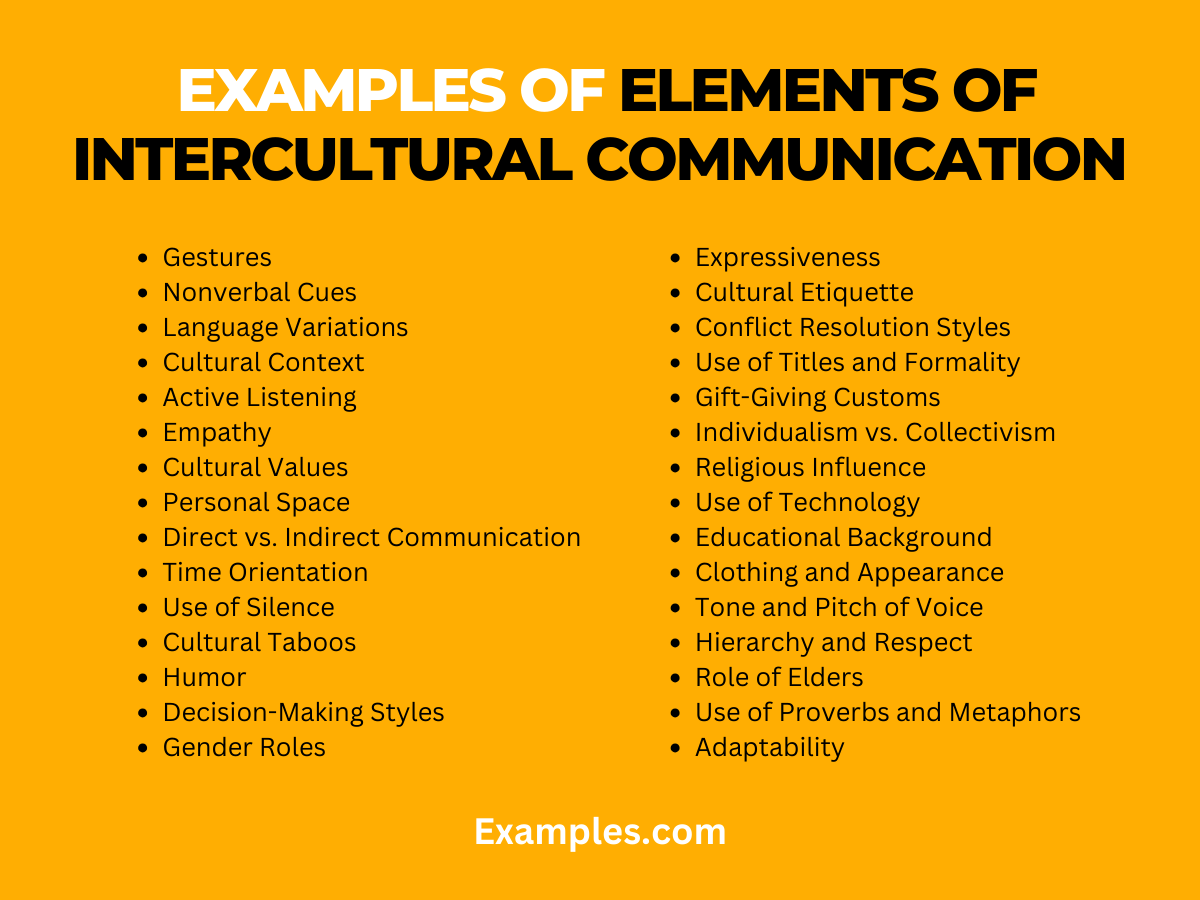29+ Elements of Intercultural Communication Examples
Unlocking the intricacies of global interaction, this guide delves into the Elements of Intercultural Communication. Navigating the diverse landscape of human connection, it illuminates how cultural nuances shape dialogue, conflict resolution, and understanding. Explore vivid Communication Examples that showcase the dynamic interplay of values, gestures, and language across cultures. Enhance your grasp of the core Elements and enrich your communication toolkit for meaningful interactions in our interconnected world.
What is Elements of Intercultural Communication?

The Elements of Intercultural Communication encompass the fundamental building blocks that shape interactions between individuals from diverse cultural backgrounds. In simple terms, it refers to the key components influencing cross-cultural exchanges, including language, nonverbal cues, values, and customs. Understanding these elements is crucial for navigating the complexities of communication in a globalized world, fostering mutual understanding and successful connections.
What is the best example of Elements of Intercultural Communication?

In the bustling streets of New York City, a multicultural project team gathered to collaborate on a groundbreaking initiative. The scenario perfectly exemplifies the Elements of Intercultural Communication. Despite linguistic diversity, the team’s commitment to active listening, respect for varying perspectives, and adapting communication styles showcased the core elements. This dynamic interaction resulted in a successful project, highlighting the significance of understanding and applying these elements in fostering cooperation and innovation across cultures.
30 Examples of Elements of Intercultural Communication

- Gestures: In some cultures, a nod signifies agreement, while in others, it may convey understanding.
- Nonverbal Cues: The use of eye contact varies, with some cultures valuing direct eye contact and others considering it impolite.
- Language Variations: The same language may have different dialects, impacting communication based on regional nuances.
- Cultural Context: Understanding the historical and societal context is crucial for effective communication.
- Active Listening: Actively engaging in listening, asking questions, and providing feedback promotes effective cross-cultural communication.
- Empathy: Sensitivity to others’ emotions and perspectives is essential for building meaningful connections.
- Cultural Values: Varied cultural values influence communication preferences and expectations.
- Personal Space: Differing preferences for personal space impact interactions; some cultures value proximity, while others prioritize distance.
- Direct vs. Indirect Communication: Some cultures prefer direct communication, while others use indirect approaches.
- Time Orientation: Varying attitudes toward time impact punctuality and scheduling in different cultures.
- Use of Silence: In certain cultures, silence holds meaning and may be a form of communication.
- Cultural Taboos: Awareness of cultural taboos prevents unintentional offense during communication.
- Humor: Cultural differences in humor require sensitivity to avoid misunderstandings.
- Decision-Making Styles: Different cultures have varied approaches to decision-making, either through consensus or hierarchical structures.
- Gender Roles: Understanding cultural expectations around gender roles is crucial for effective communication.
- Expressiveness: Some cultures value expressive communication, while others prioritize restraint.
- Cultural Etiquette: Following or understanding cultural etiquette enhances communication effectiveness.
- Conflict Resolution Styles: Cultures may favor direct confrontation or indirect approaches to conflict resolution.
- Use of Titles and Formality: Addressing individuals with proper titles and formality is significant in certain cultures.
- Gift-Giving Customs: The manner and significance of gift-giving vary widely across cultures.
- Individualism vs. Collectivism: Cultural preferences for individual or collective approaches influence communication styles.
- Religious Influence: Religious beliefs impact communication norms and taboos.
- Use of Technology: Cultural attitudes toward technology affect communication methods and preferences.
- Educational Background: Diverse educational systems shape individuals’ communication styles and preferences.
- Clothing and Appearance: Attire holds cultural significance and may convey specific messages.
- Tone and Pitch of Voice: Variations in tone and pitch convey different meanings across cultures.
- Hierarchy and Respect: Cultural attitudes toward authority and respect influence communication dynamics.
- Role of Elders: Respecting and acknowledging elders is a common cultural norm with communication implications.
- Use of Proverbs and Metaphors: Cultural idioms, proverbs, and metaphors impact communication richness.
- Adaptability: Successful intercultural communication requires adaptability to navigate diverse communication styles.
Importance of Elements of Intercultural Communication?
- Global Integration: In an interconnected world, effective intercultural communication fosters global collaboration and integration during crises.
- Conflict Resolution: Understanding cultural nuances aids in resolving conflicts that may arise during high-stakes situations.
- Community Building: It strengthens ties within diverse communities, fostering a sense of unity and mutual support during challenging times.
- Effective Decision-Making: Cultural awareness enhances the decision-making process, considering diverse perspectives for more comprehensive solutions.
- Public Perception: During crises, how communication is perceived can influence public trust and confidence; intercultural competence ensures messages resonate positively.
- Humanitarian Aid: In crises affecting multiple regions, cultural understanding is vital for providing effective and culturally sensitive humanitarian aid.
- Leadership Effectiveness: Leaders equipped with intercultural communication skills can guide teams through crises with empathy and inclusivity.
- Preventing Misunderstandings: Clear communication, grounded in cultural awareness, helps prevent misunderstandings that can exacerbate crisis situations.
What are the Elements of Intercultural Communication?
- Language Dynamics: Varied languages within a crisis context require careful consideration of linguistic nuances and potential translation challenges.
- Nonverbal Communication: Gestures, facial expressions, and body language play a crucial role, as they may convey different meanings across cultures.
- Cultural Context: Understanding the historical, social, and cultural backdrop is vital to interpreting messages accurately.
- Values and Beliefs: Diverse cultural values influence responses to crises, impacting decision-making and communication strategies.
- Conflict Resolution Styles: Different cultures approach conflict resolution uniquely, necessitating adaptable strategies during crises.
- Crisis Perception: Cultural perspectives shape how individuals perceive and interpret crises, affecting their responses and communication needs.
- Adaptability: Flexibility in communication styles is key to effectively address diverse cultural needs and sensitivities during crises.
- Leadership Communication: Leaders must demonstrate cultural competence in crisis communication, balancing authority with empathy to inspire trust and cooperation.
How to improve Elements of Intercultural Communication?
- Cultural Sensitivity Training: Implement comprehensive training programs to educate teams on diverse cultural norms, fostering understanding and adaptability.
- Diverse Communication Channels: Utilize a mix of communication channels, considering cultural preferences and ensuring information reaches diverse audiences.
- Continuous Learning: Encourage continuous learning about different cultures, staying informed about cultural shifts and nuances.
- Interdisciplinary Teams: Form interdisciplinary crisis management teams with members from diverse cultural backgrounds, leveraging varied perspectives.
- Feedback Mechanisms: Establish feedback mechanisms to gather insights on the effectiveness of communication strategies across different cultural groups.
- Language Proficiency: Invest in language training for key team members, ensuring effective communication in multiple languages during crises.
- Cross-Cultural Competency Assessment: Regularly assess and enhance cross-cultural competencies within the organization through evaluations and feedback.
- Crisis Simulation Exercises: Conduct crisis simulation exercises with a focus on intercultural communication, preparing teams to handle diverse challenges effectively.



